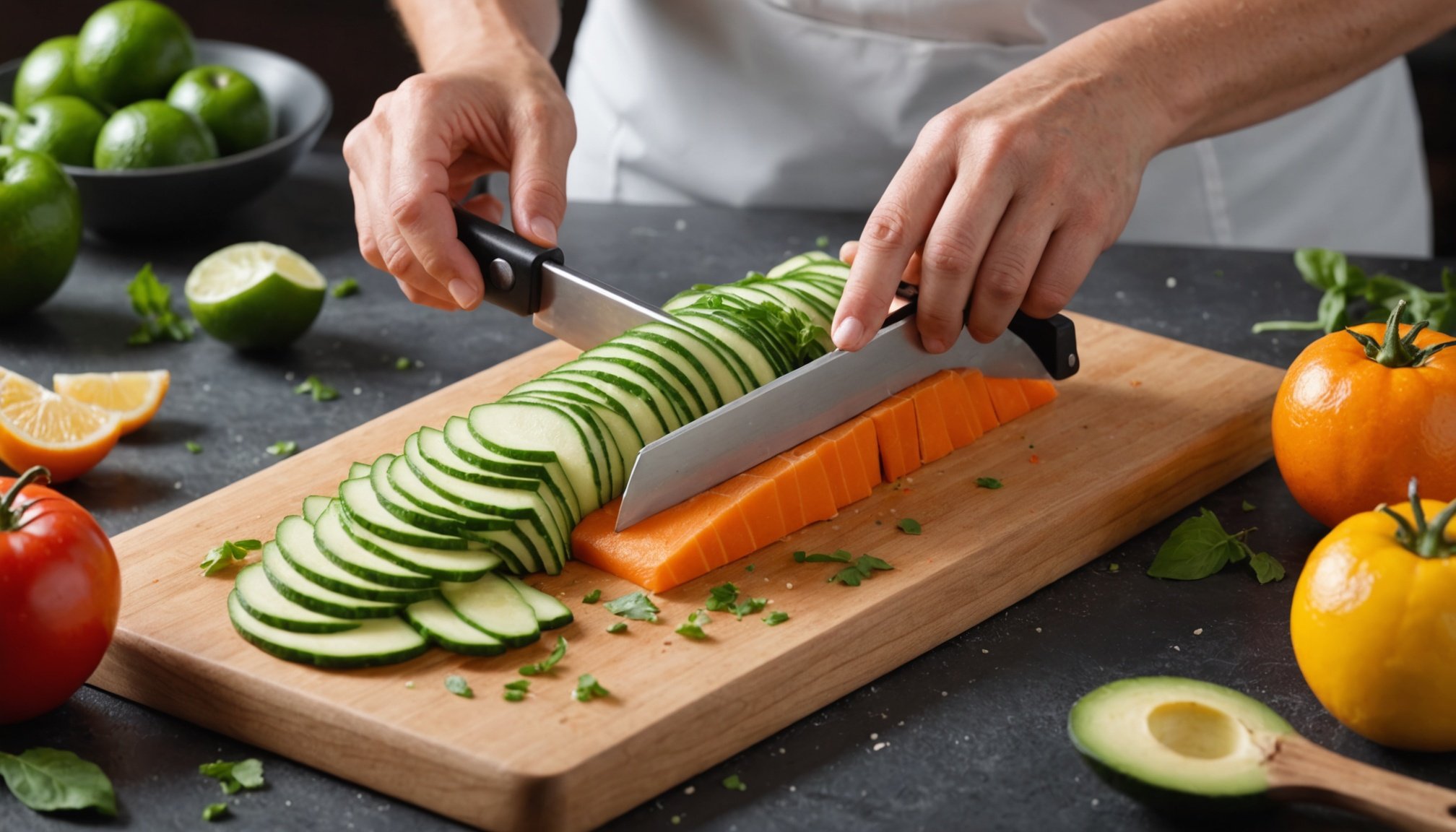Importance of Safety in Mandoline Slicing
In the culinary world, mastering mandoline techniques can elevate your kitchen skills. However, understanding mandoline safety tips is crucial to avoid injuries. Using a mandoline without caution might lead to severe cuts or injuries due to its sharp blade. It’s vital to adopt safe handling and slicing techniques.
Employing safety gear like cut-resistant gloves is recommended to protect your hands. These gloves serve as a first-line defense against potential injuries. Additionally, the proper hand placement is essential. Always grip the food with a firm hold, ensuring your fingers remain a safe distance from the blade.
Also read : Master Your Pantry: Innovative Space-Saving Hacks for Effortless Organization and Quick Access
Here are some key safety measures:
- Wear cut-resistant gloves.
- Use the mandoline’s hand guard or holder.
- Position your hands away from the blade’s path.
These mandoline safety tips can significantly reduce the risk of kitchen accidents. Understanding safe slicing techniques involves more than just donning protective gear. Practice maintaining a steady pace to avoid slips and ensuring that each slice is even. By integrating these techniques, you can harness the mandoline’s power without compromising your kitchen safety.
Also to discover : Mastering Blender Picks: Effortless Guide to Finding the Perfect Model for Crushing Nuts and Seeds
Mastering Mandoline Techniques
Exploring mandoline techniques can significantly enhance your culinary skills. A well-executed slicing efficiency makes food preparation smoother and faster. Before delving into advanced slicing methods, understanding the types of mandolines, such as straight vs. adjustable, is essential. Each type offers unique advantages for different slicing needs.
Understanding Different Mandoline Types
There are primarily two types: the straight mandoline and the adjustable mandoline. Straight mandolines are typically fixed, providing uniform slices. In contrast, adjustable mandolines allow for varied thickness settings, offering versatility in your slicing techniques. With adjustable models, you gain the flexibility to experiment with diverse recipes and find the optimal thickness for each dish.
Basic Slicing Techniques
Mastering basic slicing techniques starts with a steady hand and controlled motion. Maintain consistent pressure and focus on creating smooth, even slices. This not only enhances presentation but also ensures even cooking. Practice is key to achieving a precision level that results in uniformly sliced ingredients every time.
Advanced Slicing Methods
For a more refined approach, explore advanced methods like creating julienne cuts. This involves more intricate movements to achieve thin, matchstick-like strips. Perfecting these techniques transforms simple ingredients into visually appealing presentations, elevating your dish’s aesthetic.
Preparing Ingredients for Optimal Slicing
Achieving optimal slicing with a mandoline begins with meticulous ingredient preparation. Properly washed and trimmed vegetables are vital for seamless slicing. Ensure all residues and dirt are removed, as these can impair the blade’s performance. Trimming involves removing any blemishes or thick stems that might hinder even slicing.
To maximise your slicing preparation, the sizing and shaping of food items should not be overlooked. Aim for consistent thickness to facilitate an even cut. Chunky vegetables such as potatoes and carrots may benefit from being halved or quartered. This technique provides stability and reduces resistance, which can lead to more uniform slices.
Certain foods naturally complement a mandoline’s capabilities. Firm vegetables like cucumbers and onions are highly recommended for their ability to maintain structure during slicing. Delicate produce, however, may require a gentle touch or alternative techniques.
In summary, comprehensive food prep ensures your ingredients are ideally suited for the mandoline. By adhering to recommended practices for washing, trimming, and shaping, you guarantee smoother operation and precision with each slice. This preparation aligns with your goal of achieving professional-looking results in the kitchen.
Troubleshooting Common Mandoline Issues
Mandoline slicers are invaluable tools, but they can pose distinct challenges. Understanding mandoline troubleshooting is essential to resolving issues efficiently.
Handling Food That Sticks
A common issue with mandoline slicers is food sticking to the blade, disrupting slicing efficiency. To prevent this, lightly coat the blade with a food-safe oil before use. A sharp, clean blade also reduces resistance, minimizing sticking. Consider chilling the produce briefly, as firmer foods are generally easier to slice.
Addressing Uneven Cuts
Uneven cuts can result from improper pressure or speed. Ensure even pressure is applied consistently, and avoid rushing through slices. Regularly check the blade for sharpness; a dull blade can also contribute to inconsistent output. Adjust the slicer settings, if possible, to better suit varying textures of your ingredients.
Maintaining Your Mandoline
Proper maintenance is crucial for kitchen safety and long-term performance. After each use, clean the mandoline promptly with warm, soapy water. Avoid abrasive pads that can damage the blade. Regularly check for wear and tear, replacing any dull blades to ensure optimal function. By addressing these common issues, you can extend the lifespan of your mandoline while ensuring precise and safe slicing.
Importance of Safety in Mandoline Slicing
Operating a mandoline without care can result in potentially serious injuries, underscoring the necessity for rigorous mandoline safety tips. The sharpness of the blade can cause cuts, making proper kitchen safety protocols essential to prevent accidents.
Employing safety gear, such as cut-resistant gloves, is highly recommended. These gloves provide a necessary shield, greatly minimizing the risk of injury. Additionally, proper hand placement plays a crucial role in safe operation. Maintaining a firm grip on the food while keeping your fingers a safe distance from the blade is vital.
Consider these measures to boost safety:
- Invest in quality safety gear like gloves.
- Utilize the hand guard or holder supplied with your mandoline.
- Position hands mindfully to avoid contact with the blade.
Incorporating these strategies alongside practiced slicing techniques not only reduces risk but enhances your confidence in the kitchen. Practice is invaluable; by maintaining controlled movements and consistent pressure, you secure precise, even slices each time. By focusing on safety and technique, you ensure a productive and incident-free culinary experience.

